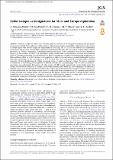Sulfur isotopes as biosignatures for Mars and Europa exploration
Abstract
Sulfur (S) isotopes are used to trace metabolic pathways associated with biological S-cycling in past and present environments on Earth. These pathways (sulfate reduction, sulfur disproportionation, and sulfide oxidation) can produce unique S isotope signals that provide insight into biogeochemical S-cycling. The S cycle is also relevant for extraterrestrial environments and processes. On early Mars, sulfur existed in different redox states and was involved in a large range of surface processes (e.g., volcanic, atmospheric, hydrothermal, and aqueous brines). Sulfur compounds have also been detected on Europa's icy moon surface, with the S cycle implicated in Europa's surface and ocean geochemistry. Given the well-established utility of S isotopes in providing a record for past life on Earth, S isotopes are an valuable tool for identifying biosignatures on Mars and Europa. Here, we review S isotopes as a biosignature, in light of two recent advances in understanding the S cycle in both Mars and Europa: (i) the measurements of δ34S in situ at Gale Crater and quadruple S isotopes (QSI) in Martian meteorites, and (ii) the identification of a likely exogenous origin of sulfur on Europa's surface. We discuss important considerations for unravelling QSI biosignatures in Martian environments, considering high and low sulfur environments, atmospheric S-MIF signals, and metabolic energy-limited niches. For Europa, we describe the potential for S isotopes to probe biogeochemistry, and identify key knowledge gaps to be addressed in order to unlock S isotopic tools for future life detection efforts. The resulting picture demonstrates how S isotopes will be a valuable tool for Mars Sample Return, and how future missions can focus on the search for environments where QSI signatures of microbial S-cycling processes have a greater chance of being preserved. For Europa, the first step will be to account for the S isotope composition of the various S pools, to recognise or rule out non-biologically mediated S isotope values, with a focus on experimental examination of potential S isotope signatures from exogenous sulfur sources.
Citation
Moreras-Marti , A , Fox-Powell , M , Cousins , C R , Macey , M C & Zerkle , A L 2022 , ' Sulfur isotopes as biosignatures for Mars and Europa exploration ' , Journal of the Geological Society , vol. 79 , no. 6 , jgs2021-134 . https://doi.org/10.1144/jgs2021-134
Publication
Journal of the Geological Society
Status
Peer reviewed
ISSN
0016-7649Type
Journal item
Description
Funding: This work was funded by the Leverhulme Trust (RPG-2019-353) and UK Space Agency (ST/P001270/1) [C. Cousins and A. Zerkle].Collections
Items in the St Andrews Research Repository are protected by copyright, with all rights reserved, unless otherwise indicated.

